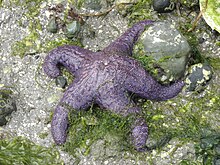Ochre sea star
| Pisaster ochraceus | |
|---|---|
 |
|
| Ganges Harbour, British Columbia | |
| Scientific classification | |
| Kingdom: | Animalia |
| Phylum: | Echinodermata |
| Class: | Asteroidea |
| Order: | Forcipulatida |
| Family: | Asteriidae |
| Genus: | Pisaster |
| Species: | P. ochraceus |
| Binomial name | |
|
Pisaster ochraceus (Brandt, 1835) |
|
Pisaster ochraceus, generally known as the purple sea star, ochre sea star, or ochre starfish, is a common starfish found among the waters of the Pacific Ocean. Identified as a keystone species, Pisaster is considered an important indicator for the health of the intertidal zone.
This sea star has five stout rays that range in length from 10 to 25 centimeters (4 to 10 in). The rays are arranged around an ill-defined central disk. While most individuals are purple, they can be orange, orange-ochre, yellow, reddish, or brown. The aboral surface contains many small spines (ossicles) that are arranged in a netlike or pentagonal pattern on the central disk. The ossicles are no higher than 2 mm. In Pisaster the tube feet have suckers on their distal ends which allow them to attach to the rocky substrate and live in heavily wave-swept areas.
Two species that can be mistaken for Pisaster ochraceus are Pisaster giganteus, which has blue rings around white or purple spines, and Pisaster brevispinus, which is pink with small white spines. These two species have different aboral spines and coloration which allows one to distinguish between the species. Evasterias troscheli may be confused with Pisaster ochraceus at times as well. It can be distinguished by its smaller disk size and longer, tapering rays which are often thickest a short distance out from their base rather than at the base as in Pisaster ochraceus.
Pisaster are dioecious but there is no sexual dimorphism and sexes can only be separated by the presence of eggs or sperm in the gonads. They reproduce by broadcast spawning, which occurs in the Puget Sound around May to July. There is no parental investment beyond spawning. Fertilization occurs in the water column and Pisaster ochraceous develops through several larval stages.
The reproductive system consists of a pair of gonads branching into each ray off a circular genital strand which is along the oral inner surface of the central disc. The gonads look like a feathery collection of tubules. In females there are orange gonads and in males they are whitish. During maturation of the gametes, the gonads increase in size and can account for up to 40 percent of the sea star's weight. The gonopores are too small to be seen, and can only be found when the sea stars are spawning.
...
Wikipedia
